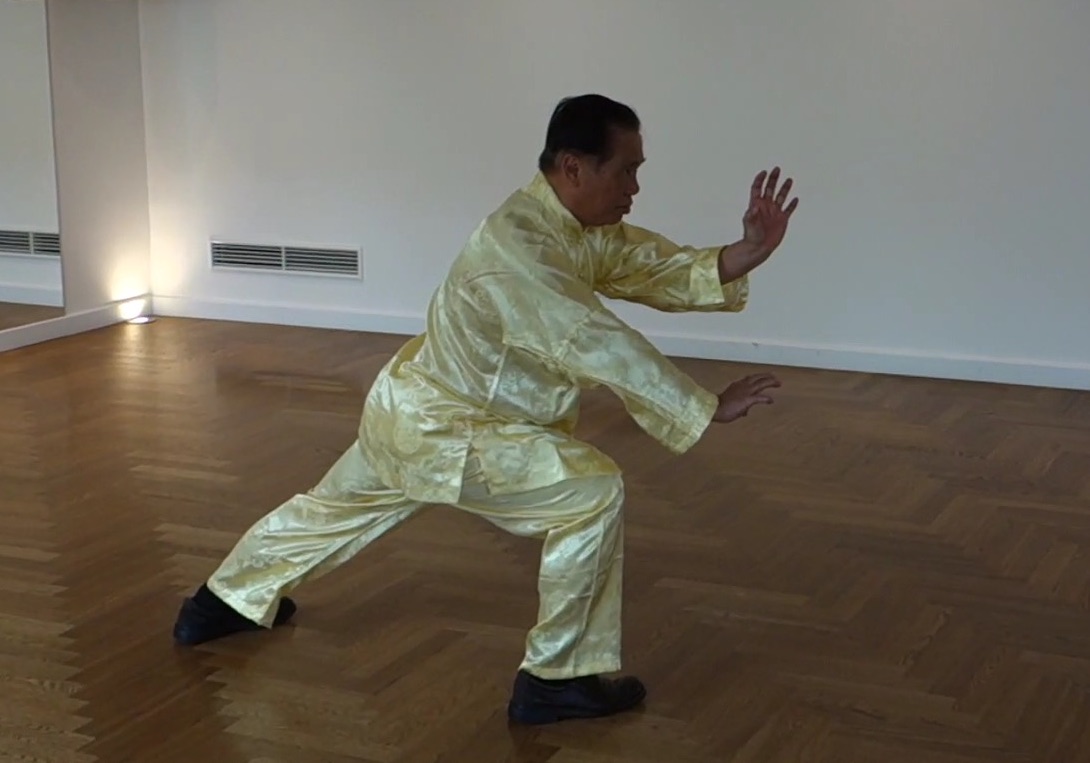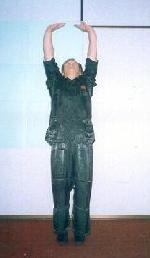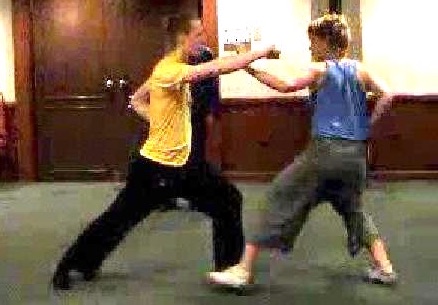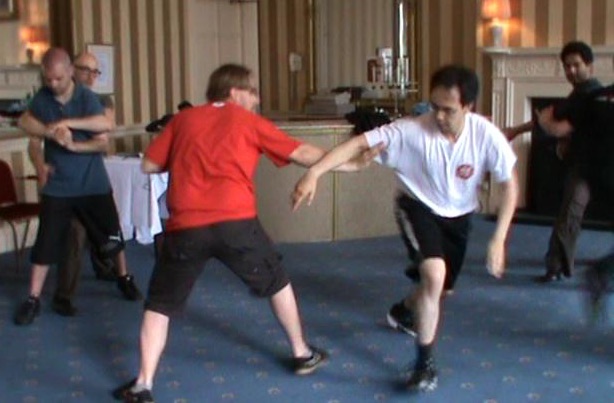SELECTION OF QUESTIONS AND ANSWERS
SEMPTEMBER 2018 PART 2

When Grandmaster Wong learned the Tiger-Set Set from Uncle Righteousness in 1954 it was hard; when he taught it in 2017 it was soft
Question 1
What are the symptoms of over-training?
— Markus, Austria
Answer
The two most common symptons of over-training are tiredness and pain.
Practicing chi kung should make the practitioner fresh and energetic, but instead he becomes tired.
Many people are tired because they lack energy. It is their body telling them to rest so that they can conserve their energy for other work.
When he over-trains, he also becomes tired. He has too much energy that his physical body can bear, so his body asks him to rest so that his body can catch up with the increase of energy.
When someone practices chi kung, his chi flow will clear his blockage. But if he has too much energy, the excess energy will push at the blockage causing pain. If there is too little energy, the energy is insufficient to push through the blockage. If he has a right amount of energy, his energy will soften the blockage, and gradually clear it.
How much energy is a right amount? It depends on various factors, like his state of health and the conditions of his body. But he will know from experience. It is like eating. How much food is a right amount? If the food is insufficient, he feels hungry. If it is excessive, he feels uncomfortable. He feels satisfied with the right amount. When he has a right amount of energy, he feels fresh and energetic.
Question 2
What should we do to prevent over-training?
Answer
An excellent way to prevent over-training is not to enter too deeply into a chi kung state of mind. Most other students do not know how to enter into a chi kung state of mind, and they practice gentle physical exercise using chi kung techniques but do not derive chi kung benefits.
In the case of our students, if they enter too deeply into a chi kung state of mind, they may over-train. Hence, for our students, they need not think of how to get the best from their training. If they get the best, it is too much benefit, resulting in over-training. If they just get less than 30% of their potential, it is more than sufficient.
Let us use an analogy. If one earns 2000 euros a month, 30% is only 600 euros and it may not be enough. If he earns 200,000 euros a month, 30% is 60,000 euros, which is a lot of money. We transfer euros to chi kung benefits. Our students operating at 30% get 60.000 unts of benefits, whereas others who do not know how to enter into a chi kung state of mind get 2000 units of benefits operating at 100%.
200,000 units of benefits is 100 time that of 2000 units of benefits. Is it reasonable to say that our chi kung is 100 times better the chi kung practiced by other people? Those who attend my intensive or regional courses, have a chi flow on the very first day of my courses. Other students cannot generate a chi flow after 100 days. Chi flow is the essence of chi kung, Without chi flow, students cannot have any chi kung beneifts.
Our certified instructors in their regular classes can also help their students to generate a chi flow on the very first day. But because they have more time with their students, like a three-month class, they take slightly longer time to help their students with chi flow for the students' benefit. My intensive courses are three to five days, and my regional courses three to four hours. So I have to help students to generate a chi flow very quickly.

Lifting the Sky
Question 3
Sifu, is the softening of Shaolin Kungfu in our school due to the progress of your own kungfu development? Of course, the softness is also very powerful.
— Sifu Angel Oliveras, Shaolin Wahnam Puerto Rico
Answer
Yes, the softening of Shaolin Kungfu is due to my own progress in kungfu development. It is also due to the improvement in our teaching methodology.
Other people may not understand that our kungfu is soft but is also very powerful. Most people may wonder how any movement can be soft and powerful. They associate power with muscular strength.
But those in Shaolin Wahnam can understand why being soft can be powerful, because they have internal force. To most people, the term "softness" may not convey the intended meaning. A more understandable term is "flow". Our kungfu has become more flowing. One has to be "soft", or not tensing his muscles, to be flowing. The more relaxed he is, the better is the flow, and the better the flow, the more force it will generate if internal force, not muscular strength, is used.
When I stated practicing Shaolin Kungfu with Uncle Righteousness more than 60 years ago, it was hard. I had to tense my muscles to produce muscular strength. When I learned Wuzuquan about 45 years ago in the 1970s, my siheng, Sifu Chee Boon Leng, who taught me on behalf of his father, Sifu Chee Kim Thong, frequently told me, "mg mian yong lak", which is the Fujian dialect of "do not use strength". This made my kungfu movements soft, but at that time I had no internal force, though there was no double that my classmates had a lot of internal force and they were soft.
I learned internal force about 40 years ago from Sifu Ho Fatt Nam. He taught me "One-Finger Shooting Zen". My kungfu movement had to be flowing, which generated internal force.
When I learned from Sifu Choe Hoong Choy about 30 years ago, he taught me to use Siu Lin Tou, the fundamental set in Wing Choon Kungfu, to develop internal force. I had to consolidate flowing energy. I would not call my kungfu movement "soft", though it was flowing.
Later when I practiced and taught Taijiquan, I became more soft. As Taijiquan was the climax of Shaolin Kungfu development, initiated by the great Zhang San Feng, my kungfu movements became soft too.
Question 4
I have practiced chi kung from another school. My teacher of that school told me that I should follow the procedure of an exercise exactly as he taught us, but you said that we could perform an exercise not in the same order you taught us. I am a bit confused. Can you please explain?
— Martin, United Kingdom
Answer
The teacher of the other school had good reasons for what he said. He probably did not want his students to make mistakes practicing a chi kung exercise in a different way from what he taught. This is the view of most chi kung schools.
Suppose the procedure of an exercise is A, B, C D. Most schools will want their students to practice A, B, C, D and not in any other order.
Our school, Shaolin Wahnam, is different from many other schools, and here is one of the differences. Another big difference is chi flow. We specifically spend some time for chi flow, but most other schools do not have chi flow. For the purpose of answering your question, we shall leave out chi flow, although chi flow is actually very important in our school.
We shall take a same exercise,. The procedure is A, B, C, D where A is standing upright, B performing the techniques of the exercise, C massaging the face, and D thinking of the dan tian, or abdominal energy field.
Instead of following the recommended order, A, B, C, D, can a practitioner perform A, B, D, C, or D, C, B, A, or in any other order? "No" in other schools, but "yes" in our school.
Let us take a set of exercises, like the Eight Pieces of Brocade, or "Ba Duan Jin" in Chinese. In our school, the Eight Pieces of Brocade are the first eight exercises of the Eighteen Lohan Hands. The eight exercises in Eight Pieces of Brocade, or the first eight exercises of Eighteen Lohan Hands, are represented as 1, 2, 3, 4, 5, 6, 7, 8.
In most other schools students have to perform 1, 2, 3, 4, 5, 6, 7, 8, but in our school students can perform the eight exercises in any order, like 2, 3, 6, 7, 1, 5, 8, 4 or 8, 7, 6, 5, 4, 3, 2, 1.
Another big difference is that in most other schools students need about 1 hour to perform their chi kung, but in our school students need only 10 minutes. Our students choose only one out of the eight exercises, though they may perform more or all if they like, but the total time of their training session is still about 10 minutes even when they choose more than one exercise.

A Vasic Shaolin Combat Sequence
Question 5
I very much enjoy reviewing the basic combat sequences. The more that I train, and the more martial artists of other schools that I meet, the more I realize that I can just use fundamental Shaolin Kungfu to overwhelm almost everyone that I meet unless they are already experts or masters in their own right.
— Frederick Chu, USA
Answer
The basic combat sequences of both Shaolin Kungfu and Wahnam Taijiquan are complete, and cover all the four categories of attack, namely striking, kicking, felling and chin-na. Many martial arts are not complete. If you kick a Boxer, catch the leg of a Taikwondo practitioner, strike a Judoka, or grip the arm of Karateka, they have no counters in their repertoire to counter you.
Although we call them "basic", many martial artists consider them advanced. They are basic because any kungfu practitioner from our school would know them. If you practice them well, not only you can handle any attack, but also can defeat most opponents unless they are experts or masters.
Question 6
When I use Baguazhang, only one person that I have met stood any chance against me, and he is a master in his sixties who has been training for forty years. Thank you again, Sifu, for so generously and openly pass on these arts!
Answer
In our school, Baguazhang is a selective art. After learning the basics, students select one or some arts, like Baguazhang, Xingyiquan, Praying Mantis, Eagle Claw, Wing Choon and Cho-Li-Fatt, to further their practice
While I am generous in teaching these arts, the credit goes to you. If students do not practice a selected art well, they will be unable to use them to defeat others.

Baguazhang sparring
Question 7
Without meaning to brag, but to simply state how effective your teachings are, I have sparred and done Pushing Hands with a handful of masters who have trained for thirty or more years and defeated them decisively in all avenues, including level of sensitivity, amount of internal force, and ability to directly use kungfu techniques.
Answer
Congratulations for your remarkable achievement, and thank you for your kind comments. As far as I know, ours is the only school that teaches students how to use their kungfu for combat, and how to develop internal force.
Our group work in working out the combat application of every pattern in the set students are learning, is very useful. It opens the students' mind and enables them to apply any pattern in any set for combat. The principles I often mention while they demonstrate the combat application of the allotted patterns, are also very useful, not just for kungfu but also for their daily life.
Question 8
It is really bewildering to me that a Chen style Taijiquan expert saw me demonstrate some Baguazhang and outright told me that he had no chance in free sparring against me, and would only do stationary Pushing Hands with me.
I defeated another Hung Gar master in sparring using a tricky application of "White Monkey Presents Fruit" from the Swimming Dragon set to strike his groin from a kneeling position.
Editorial Note: Frederick's questions will be continued at September 2018 Part 3 issue of the Question-Answer Series.
Answer
You have done very well in Baguazhang. I am sure you will make a good Baguazhang teacher and spread the benefits of this art to many people.
Congratulations for impressing the Chen Style Taijiquan expert and defeating the Hoong Ka Kungfu master.
The Pushing Hands and the Striking Hands, including the tactics, are very useful. If you get to the back of the Chen Style Taijiquan expert, he will be very surprised.
If the Hoong Ka Kungfu masters manages to defend against your "White Money Presnets Fruit", follow up with a second attack, and then a third attack if necessary, pressing him against a wall. You must cover him adequately as you attack.
You must practice well these patterns in a sequence beforehand, and apply the sequence relentlessly on your opponents but with good coverage for your own safety.
If you have any questions, please e-mail them to Grandmaster Wong via his Secretary at secretary@shaolin.org stating your name, country and e-mail address.
LINKS
Selected Reading
- Similarities and Differences of Tiger-Crane Set
- Ancient Art for Modern Era
- Frequently Asked Questions on Taijiquan
- Tapping into Cosmic Love and Wisdom
- The Valley of Monuments
